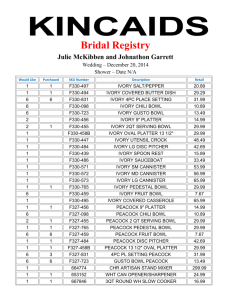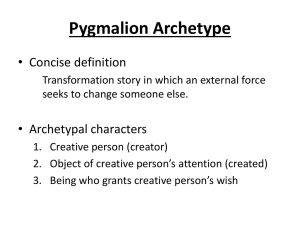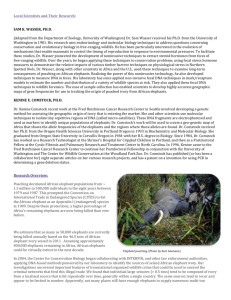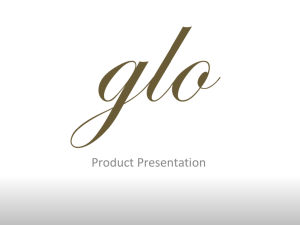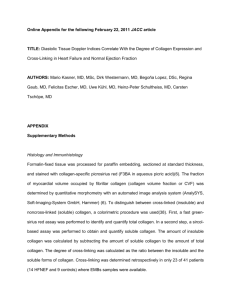Sampling of Ivory for Molecular Analysis
advertisement
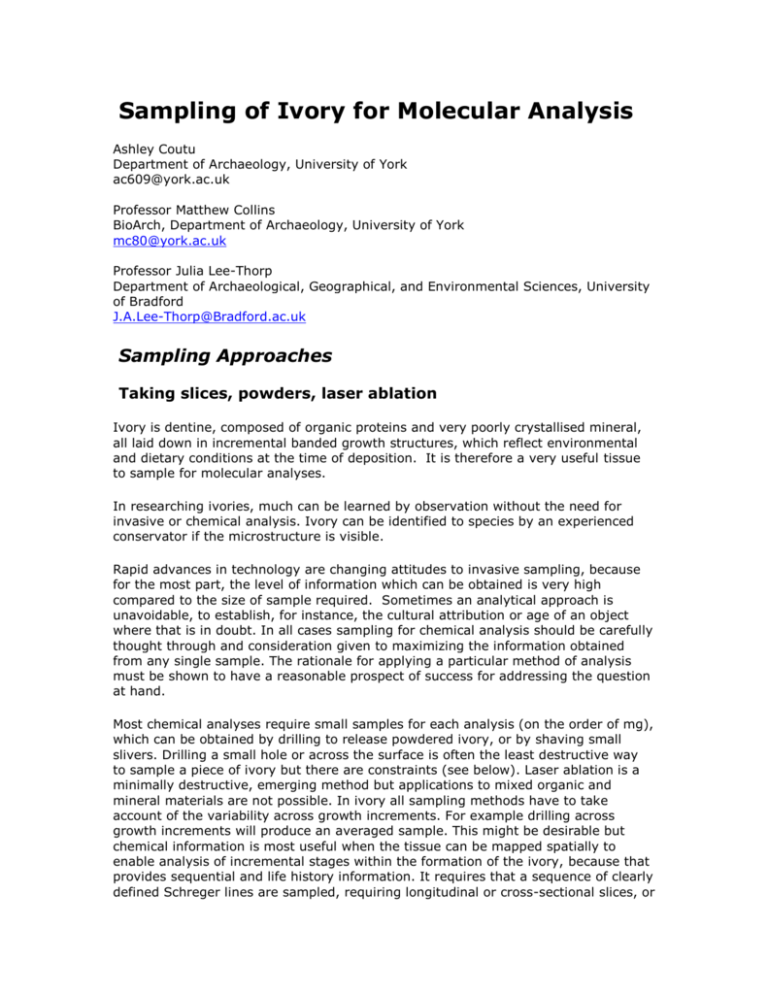
Sampling of Ivory for Molecular Analysis Ashley Coutu Department of Archaeology, University of York ac609@york.ac.uk Professor Matthew Collins BioArch, Department of Archaeology, University of York mc80@york.ac.uk Professor Julia Lee-Thorp Department of Archaeological, Geographical, and Environmental Sciences, University of Bradford J.A.Lee-Thorp@Bradford.ac.uk Sampling Approaches Taking slices, powders, laser ablation Ivory is dentine, composed of organic proteins and very poorly crystallised mineral, all laid down in incremental banded growth structures, which reflect environmental and dietary conditions at the time of deposition. It is therefore a very useful tissue to sample for molecular analyses. In researching ivories, much can be learned by observation without the need for invasive or chemical analysis. Ivory can be identified to species by an experienced conservator if the microstructure is visible. Rapid advances in technology are changing attitudes to invasive sampling, because for the most part, the level of information which can be obtained is very high compared to the size of sample required. Sometimes an analytical approach is unavoidable, to establish, for instance, the cultural attribution or age of an object where that is in doubt. In all cases sampling for chemical analysis should be carefully thought through and consideration given to maximizing the information obtained from any single sample. The rationale for applying a particular method of analysis must be shown to have a reasonable prospect of success for addressing the question at hand. Most chemical analyses require small samples for each analysis (on the order of mg), which can be obtained by drilling to release powdered ivory, or by shaving small slivers. Drilling a small hole or across the surface is often the least destructive way to sample a piece of ivory but there are constraints (see below). Laser ablation is a minimally destructive, emerging method but applications to mixed organic and mineral materials are not possible. In ivory all sampling methods have to take account of the variability across growth increments. For example drilling across growth increments will produce an averaged sample. This might be desirable but chemical information is most useful when the tissue can be mapped spatially to enable analysis of incremental stages within the formation of the ivory, because that provides sequential and life history information. It requires that a sequence of clearly defined Schreger lines are sampled, requiring longitudinal or cross-sectional slices, or cores, to be taken through a tusk. This is obviously a very invasive method. An alternative used to exploit the life history archive incorporated in the increments and rather similar to tree-coring, is to remove thin (ca. 0.5cm2) cores at designated points along a tusk, using a corer. The cores are then sub-sampled by slicing or drilling and the holes repaired by a professional conservator using ivory powder mixed with adhesives to allow the tusks to be replaced in their permanent exhibition. A constraint for all drilling/cutting methods is that since heat is generated, steps must be taken to avoid over-heating (slow speeds and/or water cooling). Researchers and museum staff should also be aware that due to CITES regulations on certain types of ivories (Indian and African elephant ivory), the transport of samples of (modern and historical) ivory, even if powdered in very small vials, across national borders is illegal without a permit. You can wait up to 6 months for a CITES permit to access and transport this material. Stable and Radiogenic Isotopes What the different isotopes can tell us The most common stable light isotopes to measure in either the collagen or mineral components of ivory are those of nitrogen (15N), carbon (13C), oxygen (18O), and hydrogen (2H) and more rarely, sulfur (34S). All can be measured from the collagen (protein) component in the ivory (which is thought to reflect the protein component of diet), while 13C and 18O can also be measured in the mineral fraction (representing the bicarbonate isotope values of the blood, linked to energy metabolism, and in the case of 18O, water). For example, if we consider elephants, one of the most common sources of ivory, carbon isotope ratios provide a general indicator of the proportions of browse (trees) vs graze (grasses) in their diet, or whether the elephants ate foods from densely shaded forests. In environments typically inhabited by elephants, trees and shrubs are C 3 and isotopically distinct from C4 grasses, and plants in deep forests have very low, distinct 13C values. Nitrogen isotopes in ivory come from plant proteins which reflect the nature of the nitrogen cycle in that habitat, with links, for instance, between enrichment in 15N and increasing aridity or poor, low-nutrient soils. 18O and 2H values are linked to the water ingested by the animal and in turn to rainfall and general hydrological conditions in the area. Terrestrial 34S values in calcified tissues may also be used as sourcing mechanisms because they are influenced by local geology. Hence these stable light isotopes provide information on both the animal’s ecology and its provenience or source. The most commonly measured radiogenic (or “heavy”) isotopes are strontium 87 Sr/86Sr and the many isotopes of lead (206Pb/204 Pb, 207Pb/206 Pb, 208Pb/206 Pb). These isotopes are calculated from the decay of radiogenic parent material in geological bedrock. Therefore, the measurement is actually a ratio of the radiogenic isotope to the stable isotope in that element, and because is based on radioactive decay of the parent material, measures the age of the bedrock. This in turn can be used to determine what type of geology the animal is roaming on, and these isotopes are therefore used primarily for provenancing ivory. It is also possible to use a combination of 15N, 13C and 87Sr/86Sr to definitively distinguish marine mammal ivories from terrestrial animal ivories. This is especially useful when material is fragmentary and cannot be distinguished on the basis of the microstructure of the ivory. Sample sizes Extraction of collagen for C, N, H and O requires enough ivory to produce around 1 mg of collagen, which is the amount required for each simultaneous 15N and 13C analysis, and similar amounts for 18O and 2H analysis, and the two sets must be done separately. Collagen quality can be conveniently be assessed using the C:N ratio (the theoretical atomic ratio is 3.1, but values of C/N are typically in the range 3.1-3.5) Approximately 20% by weight of ivory is collagen, but to ensure that sufficient collagen for analysis and replication, sample sizes are typically in the order of 30-150 mg. Extraction of mineral for 13C, 18O 87Sr/86Sr and Pb requires 20-50 mg of material, dependent on how many elemental analyses are run and duplicates if necessary. The sample taken for the collagen extraction is separate from the mineral extraction, so if measuring all light isotopes on one ivory sample, it is possible that 50-200 mg of material will be needed. Combining Analyses Collagen extracted for stable isotope analysis is suitable for protein sequencing. The use of acid to extract collagen will cause severe hydrolysis of any residual DNA, but if EDTA extraction was used in order to isolate collagen, any surviving insoluble collagen could form the basis of a subsequent DNA analysis. However, it would seem more logical to extract the DNA first (see section below). Trace Elements Another method for determining provenance in biological tissues such as ivory is trace element analysis. This method measures the amount, in parts per million (ppm) in ivory and is therefore used often to measure heavy elements that collect in the mineral portion of the bone, such as strontium (Sr) and zinc (Zn). This method distinguishes populations based on concentrations of specific elements in the ivory. The most common methods used are through neutron activation, atomic absorption spectroscopy, and inductively coupled mass spectrometry (ICP-MS), all of which require small sample sizes of between 1-200 mg for analysis. Trace element (and light element isotope) analysis should be avoided in archaeological samples due to the risk of diagenetic exchange with the burial environment. Dating ivory It is often beneficial to date ivory, particularly when dating artefacts or pieces that are pre-CITES ban, or are antique (over 100 years old according to CITES regulations) and therefore do not require a CITES permit for transport or analysis. The age range for radiocarbon dating is between 400 and 50,000 years. Dating is most routinely analysed on collagen. Therefore, it is also possible to extract collagen for combining radiocarbon dating with isotope analyses. When using conventional radiocarbon dating, samples of 1-10 grams are required. If using accelerator mass spectrometry (AMS) samples of 0.1 to 1 mg of carbon are required (approximately 50% of the mass of collagen is carbon), meaning that typical sample sizes are usually between 50 – 200mg. Protein Sequence Analyses (ZooMS) What proteins can tell us The dominant protein in ivory is collagen, which is very slowly evolving and in order to discriminate between ivories, the species should have an evolutionary divergence time of at least 5 million years. As yet, no other proteins have been routinely extracted from ivories. Sample size In principle it is not necessary to sub-sample the ivory with this method as enough collagen can be extracted using warm buffered water (65 degrees C) PH 8 for 2 hours. It does not result in any measurable deterioration of the ivory. The minimum sample size this analysis can be conducted on is yet to be determined, but appears to be less than 1 milligram. DNA Analysis What DNA can tell us The advent of next generation sequencing technologies means that in the future, the potential of DNA analysis on ivory is almost limitless. So far, mitochondrial DNA (mtDNA) and single-nucleotide polymorphism (SNP) data have been used to source ivory and explore population genetics, and we envisage that such analyses will increase in number and resolution. As a consequence of these new technologies, we would strongly recommend that researchers (working with museums) no longer isolate DNA for targeted PCR amplification. Instead, we envisage the production and immortalisation of DNA libraries for each sample. The libraries would ideally be curated by the museum and if not, by another national facility or failing that the researcher themselves. These libraries are DNA copies of the original genome and are not subject to CITES regulations, thereby enabling them to be transported across national boundaries. Sample size Approximately 20 mg of ivory. Sample size may vary slightly if the ivory is poorly preserved. Combining with other analyses In order to prepare a DNA library the DNA is typically extracted using EDTA, which damages the mineral phase and prevents the residue from being analysed for inorganic isotope analysis, although this has never been verified. The protein is destroyed enzymatically in order to liberate the DNA, again, preventing organic isotope analysis or protein sequence analysis. If the enzymatic digestion is omitted this typically halves the total DNA yields but would allow further analyses of the residual collagen. However the EDTA (C/N = 5) is difficult to fully remove and will interfere with radiocarbon and isotopic analysis.

